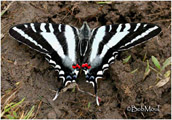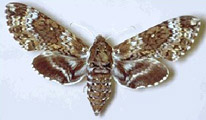Native Plants
Search for native plants by scientific name, common name or family. If you are not sure what you are looking for, try the Combination Search or our Recommended Species lists.
Asimina triloba
Asimina triloba (L.) Dunal
Pawpaw, Common Pawpaw, Custard Apple, Indian Banana, Wild Banana
Annonaceae (Custard-Apple Family)
Synonym(s): Orchidocarpum arietinum
USDA Symbol: ASTR
USDA Native Status: L48 (N), CAN (N)
Common pawpaw is a small, short-trunked tree or large, multi-stemmed shrub, 10-40 ft. tall, with large, tropical-like leaves. Young shoots and leaves are covered with a rusty down, later becoming smooth. The thick, bright-green, deciduous leaves turn yellow-green in fall. Not particularly showy, but interesting, purple, six-petaled flowers are borne singly in leaf axils before leaf emergence. Large, cylindric, dark-green or yellow, edible fruit follows.
Common Pawpaw is the northernmost New World representative of a chiefly tropical family, which includes the popular tropical fruits Annona, Custard-apple, Sugar-apple, and Soursop. The wild fruit was once harvested, but the supply has now decreased greatly due to the clearing of forests. The small crop is generally consumed only by wildlife, such as opossums, squirrels, raccoons, and birds. Attempts have been made to cultivate Common Pawpaw as a fruit tree. First recorded by the DeSoto expedition in the lower Mississippi Valley in 1541. The name Common Pawpaw is from the Arawakan name of Papaya, an unrelated tropical American fruit.
Plant Characteristics
Duration: PerennialHabit: Tree
Root Type: Tap
Leaf Retention: Deciduous
Leaf Arrangement: Alternate
Leaf Complexity: Simple
Leaf Shape: Obovate
Leaf Venation: Pinnate
Leaf Pubescence: Glabrous
Leaf Margin: Entire
Leaf Apex: Acuminate
Leaf Texture: Smooth
Breeding System: Flowers Bisexual
Fruit Type: Berry
Size Notes: Tree up to 40 feet tall; trunk diameter up to 10 inches; crown broad and spreading.
Leaf: Alternate, simple, broadly elliptic, pointed at the tip, narrowed to the base, without teeth, rusty-hairy when young, but becoming smooth, paler on the lower surface, up to 12 inches long, up to 6 inches wide.
Autumn Foliage: yes
Flower: Borne singly when the leaves begin to unfold, up to 1 1/2 inches across.
Fruit: Fleshy, oblong, thick, up to 6 inches long, greenish yellow, with several dark brown seeds.
Bloom Information
Bloom Color: White , Red , Yellow , PurpleBloom Time: Apr , May
Distribution
USA: AL , AR , DC , DE , FL , GA , IA , IL , IN , KS , KY , LA , MD , MI , MO , MS , NC , NE , NJ , NY , OH , OK , PA , SC , TN , TX , VA , WI , WVCanada: ON
Native Distribution: FL to TX, n. to w. NY, s. Ont., MI, IL, s.e. IA & s.e. NE
Native Habitat: Ditches, Ravines, Depressions, Flood plains, bottomland
Growing Conditions
Water Use: MediumLight Requirement: Sun , Part Shade , Shade
Soil Moisture: Moist
CaCO3 Tolerance: Medium
Soil Description: Rich, moist, slightly acid soils. Sandy, Sandy Loam, Medium Loam, Clay Loam, Clay
Conditions Comments: This is a good understory tree. No serious disease or insect problems. The fruit can create a mess on sidewalks and patios, but this can be minimized by planting only one tree; pawpaws seldom set much fruit without cross pollination.
Benefit
Use Ornamental: Understory tree, Aromatic, Fall conspicuousUse Wildlife: Small mammals relish the fragrant fruit which tastes banana-like. Fruit-mammals, Fruit-birds.
Use Food: First Nations People and European settlers have long used the fruit as food. First Nations People used the fruit fresh and made it into cakes and sauces, or dried and used it as winter food. Some people reportedly develop contact dermatitis after frequent exposure to the fruits. (Athenic) EDIBLE PARTS: Raw berries (fruits) in small quantity. The fruits generally fall to the ground before they are ripe and therefore must be ripened at home. Ripen outdoors -- the smell is overpowering. The fruit is ripe when the skin turns brown. The fruit can be eaten raw, cutting them in half like an avocado, removing the large oblong seeds and sprinkling with lemon juice. (Poisonous Plants of N.C.)
Warning: The fruit, though edible, can cause skin irritation and gastrointestinal upset in some individuals. POISONOUS PARTS: Fruit, leaves. Skin irritation when handling fruit; low toxicity when ingested. Fruit edible but some symptoms might include severe stomach and intestinal pain for some people.
Conspicuous Flowers: yes
Attracts: Birds , Butterflies
Deer Resistant: High
Butterflies and Moths of North America (BAMONA)
|
Zebra Swallowtail (Eurytides marcellus)  Larval Host |
Pawpaw sphinx (Dolba hyloeus)  Larval Host |
Propagation
Description: Trees are easily grown from scarified/stratified seed. Fall sow in a shady location. Some sources say seed is the only method of propagation while other say increase is possible by root cuttings or layering.Seed Collection: Fruit often drops from tree while still hard, green and sour. These fruits can be stored in single layers on trays until pulp begins to soften. Remove seeds and air dry before storing.
Seed Treatment: Follow scarification with a 60-90 day stratification at 41 degrees.
Commercially Avail: yes
Mr. Smarty Plants says
Edible Plants for North Georgia
January 10, 2010
We are planning a forest food garden in the hollers of the N GA Mountains.
Which edible fruit, nut, berry, herb and creepers would be best for this reddish, clay-like soil? The food garden is in...
view the full question and answer
Edible Plants for a Virginia Rain Garden
October 21, 2009
Can you recommend edible plants that would be appropriate for use in a rain garden? I'm located in Charlottesville, VA, but this can be in general as well.
view the full question and answer
Attracting butterflies in Tennessee
July 03, 2009
What flowers and plants do the caterpillars in Tennessee eat? And do you know what butterflies live in Tipton Co. Tennessee?
view the full question and answer
National Wetland Indicator Status
| Region: | AGCP | AK | AW | CB | EMP | GP | HI | MW | NCNE | WMVE |
| Status: | FAC | FAC | FACU | FAC | FAC |
From the National Organizations Directory
According to the species list provided by Affiliate Organizations, this plant is on display at the following locations:Pineywoods Native Plant Center - Nacogdoches, TX
Texas Discovery Gardens - Dallas, TX
Delaware Nature Society - Hockessin, DE
Natural Biodiversity - Johnstown, PA
Mt. Cuba Center - Hockessin, DE
Bibliography
Bibref 1186 - Field Guide to Moths of Eastern North America (2005) Covell, C.V., Jr.Bibref 298 - Field Guide to Texas Trees (1999) Simpson, B.J.
Bibref 1185 - Field Guide to Western Butterflies (Peterson Field Guides) (1999) Opler, P.A. and A.B. Wright
Bibref 1620 - Gardening with Native Plants of the South (Reprint Edition) (2009) Wasowski, S. with A. Wasowski
Bibref 841 - Native Alternatives to Invasive Plants (2006) Burrell, C. C.
Search More Titles in Bibliography
Additional resources
USDA: Find Asimina triloba in USDA PlantsFNA: Find Asimina triloba in the Flora of North America (if available)
Google: Search Google for Asimina triloba
Metadata
Record Modified: 2018-10-11Research By: TWC Staff